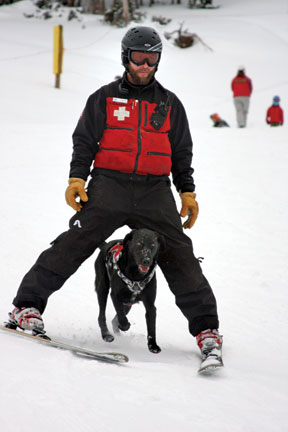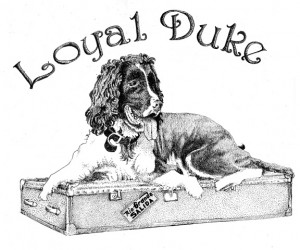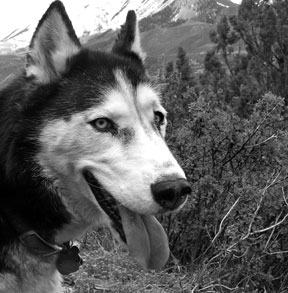Story and Photos by Mike Rosso
As a native of Black Hawk, Colorado, Aaron Peyrouse has been playing in the mountains all his life. He learned to ski at Loveland Ski Area at a young age and eventually became a full-time ski patroller. It was during those years at Loveland that he learned about avalanche rescue dogs and became intrigued. The area had employed golden retrievers trained to seek out and hunt down the scent of skiers buried in avalanches.
Peyrouse began his own research into the training of rescue dogs by referencing the certification program offered through Search And Rescue Dogs Of Colorado (SARDOC) Colorado Rapid Avalanche Deployment (CRAD). Meanwhile, he ran into an old friend in Central City who had just arrived from Montana with a fresh litter of bird-dog puppies. Peyrouse got to choose the pick of the litter, a six-week-old black lab he named Üllr after the Norwegian god of snow and skiing.

Üllr’s rescue training began immediately. Peyrouse had chosen the pup because he was the most rambunctious of the litter and because of his “drive to chase stuff.” For weeks on end he hid the dog’s favorite toy, forcing him to use his sense of smell to locate the object. At ten weeks old, Üllr was brought to Loveland so Peyrouse could train him while on the job. He cited the dog’s “insatiable drive to look for things” as key to his success for avalanche rescue. Another training method involved having a friend restrain the dog while Peyrouse hid in the woods, forcing Üllr to find his master using only his nose. Successive training involved burying a willing volunteer in the snow (suitably dressed with a breathing hole) for a minimum of 20 minutes, ten minutes to bury and ten under the snow, before releasing the dog with the command, “Are you ready to work?” or “Go search! Search it out!” The dog would then initiate a search involving a natural grid pattern – back and forth, up and down – until he caught a whiff of the “human scent cone” which percolated from the victim through the snowpack and expanded upon reaching the surface. The rescue window for an avalanche victim is very narrow, about twenty minutes. According to a Swiss study, there is a 90 percent survival rate for a person found in the first 15 minutes after becoming buried. At 35 minutes the odds of a live recovery fall to 30 percent. After two hours the survival rate falls to three percent. A trained avalanche dog can search in 30 minutes an area which might take searchers four hours. It also can cover the same terrain as nearly 20 human searchers on foot using probe poles, thus making them invaluable for rescue efforts in avalanches. Peyrouse cites three levels in the recovery process: • Interest – getting the dog excited about looking for something. • Alert – capturing the scent cone and tracing the origin. • Indication – pinpointing the location of the victim and beginning to dig. Rescue dogs are often airlifted in to a rescue operation, lending their invaluable talents to the search. A Flight for Life Avalanche Deployment team will often pick up rescue dogs on their way to an emergency. As a licensed paramedic, Peyrouse recognizes first hand the value a rescue dog can bring to an avalanche search. After “getting sick of the I-70 corridor” he decided to find a smaller ski community for himself and Üllr. After visiting and applying at ski areas in Durango, Silverton and Telluride he was offered a job at Monarch with one stipulation: “We’ll hire you if we can hire your dog.” Peyrouse accepted the terms and moved to Salida in February of 2009. Üllr is now the official avalanche rescue dog at Monarch Mountain for the 2009-10 ski season. For more information visit: www.sardoc.org www.flightforlifecolorado.org www.1srg.org



